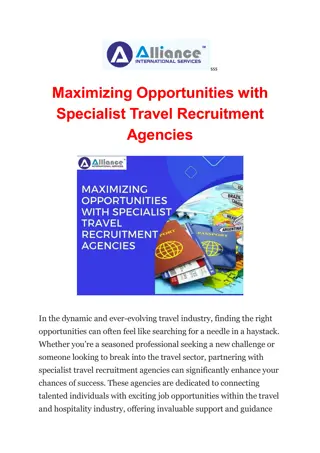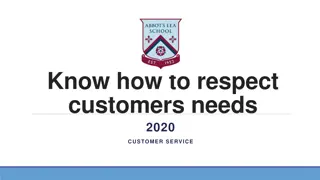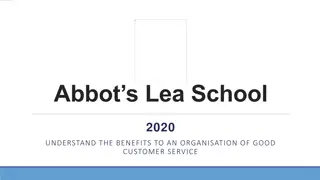Understanding Customer Behavior in the Travel Industry
This chapter explores different customer behaviors in the travel industry, ranging from leisure to business travelers, emergency travelers, and frequent flyers. It delves into how frontline service agents can best cater to each type of customer, considering their characteristics and needs. Additionally, it discusses personality types such as detail seekers and results seekers, providing insights on how to interact effectively with them. Understanding customer behavior is crucial for providing exceptional service in the airline industry.
Download Presentation

Please find below an Image/Link to download the presentation.
The content on the website is provided AS IS for your information and personal use only. It may not be sold, licensed, or shared on other websites without obtaining consent from the author. Download presentation by click this link. If you encounter any issues during the download, it is possible that the publisher has removed the file from their server.
E N D
Presentation Transcript
Learning Objectives After reading this chapter, the reader should be able to: Understand various customers characteristics Recognize the impact of culture on customer behavior Identify different customers based on their religious behavior
Interpreting Customer Behavior Customers characteristics Leisure travelers travel for pleasure and are generally excited about their trips. Frontline service agents need to show interest in their travel plans and offer assistance to the elderly and young travelers when necessary. Business travelers travel very often, and they are usually familiar with the job duties and responsibilities of airline frontline service agents.
Interpreting Customer Behavior Customers who travel due to emergencies are usually in a hurry to fly to a destination for specific purposes, and will appreciate that frontline service agents show some form of care. Frequent flyers are customers who fly frequently. They expect airline frontline service agents to be knowledgeable and to be able to give sound advice when problems occur.
Personality types Detail Seeker In 1928, Swiss psychiatrist, Carl Jung identified four groups of people based on how they process information: thinkers, sensors, feelers, and knowers. Results Seeker In 1985, Rebecca Morgan renamed them as follows: detail seeker, results seeker, excitement seekers, and harmony seekers. Excitement Seekers Harmony Seekers
Personality types Detail seekers These customers think logically, are detail oriented, and usually expect a thorough explanation of any process. Detail seekers are usually willing to wait patiently for airline service agents to seek others advice for clarification to their questions. However, they have zero tolerance for mistakes and expect honest, direct answers. Below are some useful tips and techniques when interacting with detail seekers: Show care and concern Provide accurate facts and data Include as much details as possible Speak slowly and allow time for customers to analyze the information Possible to engage in logical arguments when the need arises
Personality types Results seekers Similar to detail seekers, result seekers have zero tolerance for mistakes. These customers are concerned about time and they expect the entire check-in process to be completed quickly. Below are some useful tips and techniques when interacting with result seekers: Do due diligence before replying to queries Offering a straightforward response Reply straight to the point and keep the information short and concise Show confidence when stating point of view, and without challenging customers authority Explain the result benefits Provide two or more options to allow customers to make their own decisions
Personality types Excitement seekers These customers are usually creative, fun-loving, enthusiastic, and idealistic, and are great conversationalists. More often than not, they are disorganized and tend to jump from one activity to another, and get bored easily. Below are some useful tips and techniques for interacting with result seekers: Allow them to talk Show respect so as to build trust Show personalized care Treat them as a friend Use jokes when appropriate to diffuse tense situations
Personality types Harmony seekers Harmony seekers like to interact with others and care about how they feel. However, these customers are slow decision-makers as they do not like to take the initiative in a situation. They usually wait for others to provide them suggestions and will often seek alternative recommendations. Below are some useful tips and techniques for interacting with harmony seekers: Be friendly Offer multiple options and help these customers to make the best decision whenever possible Do not take advantage of their easy-going personality Show empathy and understanding
Culture Influences on Customer Behavior Africans Africans refer to individuals who are either natives or inhabitants of Africa. This also extends to a person and especially a black person of African ancestry. While there are many different tribes in the African continent and each has its own unique set of behavior, many Africans are influenced by mainstream Western European culture.
Culture Influences on Customer Behavior Africans Ethnicity Native Africans General characteristics Punctually is not deemed important Important to maintain good eye contact when greeting or speaking with others Never stare at others Avoid getting overly upset or frustrated with others Shake hands when meeting (both men and women) Direct eye contact is necessary Punctually is critical Prefer direct communication Maintain eye contact and smile while shaking hands Avoid confrontations Do not interrupt them when they are speaking Punctuality is important to English-speaking South Africans, while others tend to be more flexible with the concept of time African Americans/ Africans in European South Africans
Culture Influences on Customer Behavior Westerners Western culture, sometimes equated with Western civilization, Western lifestyle or European civilization, is a term used very broadly to refer to a heritage of social norms, ethical values, traditional customs, belief systems, political systems, and specific artifacts and technologies that have some origin or association with Europe.
Culture Influences on Customer Behavior Westerners Nationality American General characteristics Passionate about freedom of choice and speech Need personal space Punctual Follow rules and law Maintain eye contact and smile during conversation Casual and informal Communicate using direct language Show respect by others in the eye Need personal space Good sense of humor Acceptable to show anger and emotions in public Polite Need personal space Punctual Follow rules and regulations Sarcastic and self-depreciating sense of humor Australian British
Culture Influences on Customer Behavior Westerners Nationality German General characteristics Hardworking, efficient and disciplined Love planning schedules Punctual Problem solvers Do not give up without a solution Russian Restrained in public Time is not important Patient Reserved and toned-down Subscribe to high-context cultures South American Attitude toward time is less rigid Usually stand closer to others during conversation Enjoy social conversations
Culture Influences on Customer Behavior Arabs Arab cultures refer to the culture of the Arabs and generally extend to countries where Arabic is the dominant language. The Arab world stretches from Morocco across Northern Africa to the Persian Gulf, and is also commonly known as the Middle East and North Africa (MENA).
Culture Influences on Customer Behavior Arabs Nationality Algerian General characteristics Avoid any forms of physical contact Important to maintain eye contact when speaking Frequent use of hand gestures when speaking Avoid contradicting others in public Punctuality is not very important People of same gender keep a close distance, people of opposite gender maintain a distance from each other Speak loudly during argument Shake hands very often Public display of anger is discouraged Prefer indirect communication Place emphasis on face-saving behavior People of same gender keep a close distance, people of opposite gender maintain a distance from each other Do not like conflicts Egyptian Emirati
Culture Influences on Customer Behavior Arabs Nationality Saudi Arabian General characteristics Friendly and sociable Maintain eye contact during conversation Physical contact with the opposite gender is prohibited Reserved emotions in public Usually increase voice volume during conversation Somalian People of opposite gender maintain a distance from each other Do not establish direct eye contact Speak loudly Like to join in other people s conversations Not obsessed about time
Culture Influences on Customer Behavior Asians Asian culture is diverse and rich in cultural heritage, and comprises many nationalities, societies, and ethnic groups in the Asia continent. The continent is divided into natural geographic and cultural sub-regions, including Central Asia, East Asia, North Asia, South Asia, Southeast Asia and West Asia. Many of these Asian cultures are influenced by Western culture as a result of colonization. For example, British influence in Myanmar, Malaysia, Singapore and Hong Kong; French influence in Cambodia, Laos and Vietnam; and US influence in the Philippines.
Culture Influences on Customer Behavior Asians Nationality Cambodian General characteristics Avoid maintaining eye contact during conversations Use soft tone of voice Minimum gestures when speaking Laughing or making jokes are acceptable Comfortable with personal zone distance Maintain eye contact during conversation Speak loudly Rely on implicit communication and non-verbal cues May be aggressive Places importance on face/mianzi Warm and hospitable Use a lot of non-verbal communication during conversations, e.g. raising eyebrows or lifting the head upwards slightly to indicate "yes" or to greet friends Avoid confrontation Avoid expressing anger in public Chinese Filipino
Culture Influences on Customer Behavior Asians Nationality Indonesian General characteristics Direct eye contact should be avoided Rely on implicit communication and non-verbal cues Places importance on face/mianzi Avoid touching the other people when talking Never use left hand to give or receive things Acceptable distance depends on the space between individuals Any form of physical contact is unwelcomed Occasionally maintain eye contact Tendency to use indirect forms of communication Rare public displays of emotion Keep a distance when talking Not important to maintain eye contact during conversation Minimal gestures while speaking Public displays of anger are considered shameful and embarrassing Generally flexible about timeliness and punctuality; varies according to individuals Japanese Lao people
Culture Influences on Customer Behavior Asians Nationality Malaysian General characteristics Keep an appropriate distance during conversation Friendly but reserved Not important to maintain eye contact during conversation Volume and tone of voice may increase or change when excited Very informal Reserved Moderate tone of voice; speaking loudly in public is considered rude Rare public displays of emotion and anger Most arguments are expected to be resolved in private Eye contact is avoided during conversations Do not use gestures when speaking Tone of voice is generally soft, gentle and polite Public displays of anger are not generally accepted Pay attention to timeliness and punctuality Singaporean South Korean
Culture Influences on Customer Behavior Asians Nationality Taiwanese General characteristics Very understanding and inquisitive Maintain eye contact during conversation Limited facial expressions Openly show dissatisfaction with product or service of poor quality and demand improvement or explanation for said product or service Speaking loudly in public is considered rude Maintain eye contact during conversation Rarely express anger Public displays of emotions are only displayed to close friends and family Not particular about timeliness and punctuality Do not plan ahead of time Maintain a distance from others when speaking Do not necessarily maintain constant eye contact during conversation Express feelings of anger or happiness in public Loud tone of voice demonstrates anger Not particular about timeliness and punctuality Thai Vietnamese
Religious Behavior Christianity Christianity is the major region in many Western countries and it is the most popular religion in the world with over two billion followers. Christianity originates in the Middle East and is then spread to Europe and other parts of the world. Christian priests and nuns can be identified by their clerical collar coif (a woman's close-fitting cap, worn under a veil by nuns) and guimpe (a high-necked blouse or undergarment worn showing beneath a low-necked dress).
Religious Behavior Buddhism Buddhism is a major religion in the Eastern hemisphere. Buddhism started in northern India and later spread eastward to other Asian countries. Buddhist monks and nuns are subjected to strict codes of conduct they must not have any physical contact with someone of the opposite gender and they are not allowed to consume any alcohol. Some pious Buddhist believers also keep to these codes of conduct.
Religious Behavior Islam Islam is the world's second-largest religion and the fastest-growing major religion in the world, with over 1.8 billion followers to date. It originates in Mecca and spread to other parts of the world. Muslims are people who have professed belief in Islam. According to the Quran, Muslims are forbidden from consuming any pork, blood and alcoholic beverages. Muslim women are also not allowed to socialize with anyone of the opposite gender unless he is a close relative. As such, when making travel arrangements for a Muslim woman who is traveling alone, service agents should always try and allocate appropriate seats for the customer.
Religious Behavior Hinduism Hinduism, also known as the oldest religion in the world, is practiced mostly in India, Mauritius and Nepal. Due to the British colonization, Hinduism has also spread to other countries such as Singapore and Malaysia. Hinduism believers are forbidden to eat meat, poultry, fish or eggs. In addition, consumption of beef strictly forbidden is not allowed as cows are thought to be sacred animals and are deeply respected.
Religious Behavior Judaism Orthodox Jewish customers with religious belief in Judaism are subjected to very strict dietary restrictions and are only allowed to consume food that are kosher and conform to the regulations of kashrut (Jewish dietary law).
Clothing and Emotional Colors Service agents may sometimes be able to identify customers religious beliefs based on their outfit. The standard Muslim male clothing attire covers the shoulders and torso and legs, and extends from the navel to the knees while standard Muslim female clothing covers the entire body, with the exception of one s face and hands. [15] Male Judaism customers can be easily recognized by their kippah, a small brimless cap, usually made of cloth and worn by Jewish males. Customers choice of clothing color can also sometimes give hints to their behavior as colors can help to reveal a person s mood and behavior.
Clothing and Emotional Colors Color Black Blue Brown Green Greenish-Blue Grey Indigo Orange Pink Purple Purplish-red Red White Yellow Behavioral cues protective, formal, completeness, independent trusting, orderly, caring, shows concern practical, approachable, friendly, stable self-reliant, calm, practical, caring creative, harmonious, idealistic, calm reliable, professional, intelligent, calm organized, responsible, honest, practical sociable, optimistic, self-confident, independent understanding, warm, calm, feminine creative, daydreams, original, kind harmonious, emotionally balanced, logical, supportive, kind excited, power hungry, energetic, fast fair, impartial, neat, simple, open-minded warm, cheerful, enthusiastic, fun-loving
Other Behavior Baby boomers Baby boomers are older customers and usually refer to those who are between 50 and 60 years old. Due to the surging birth rate in the post World War II period between 1946 and 1964, there are approximately 1.4 billion baby boomers worldwide as of in 2015. These customers have high purchasing power and the money and time for travel. They are usually slow in making decisions and some might be suffering from presbyopia long-sightedness caused by loss of elasticity of the lens of the eye, occurring typically in middle and old age. These customers expect service agents to show them respect and give them extra attention. Service agents can ensure a smooth interaction with these customers by being more patient and spending additional time to satisfy their needs and demands.
Other Behavior Millennials/Generation Y This refers to the generation of people born during the 1980s and early 1990s, i.e. customers who are between the ages of 20 and 35. This group of customers relies heavily on technology and prefers to communicate via technology as opposed to face-to-face communication. When serving millennials, service agents should endeavor to keep the message short and brief whilst providing concise and accurate details as these customers usually have already done their research online before seeking assistance from service agents.
Other Behavior Customer with special needs Service agents must be very careful when interacting with these customers so as to avoid any potential conflicts or misunderstanding. Service agents should not assume that all special needs customers need help. It is best to ask these customers if they require any assistance first before offering a helping hand. If these customers travel with a companion, it is disrespectful to only talk to the passenger s companion and assume he or she will help to pass on the message.
Other Behavior LGBTQ customers LGBTQ is an initialism that stands for lesbian, gay, bisexual, transgender and queer. These customers are more often than not, sensitive about being treated equally and expect service agents to respect their lifestyles. Service agents must not discriminate these customers in any way and should offer the same quality and standard of service as they would to the other customers.
Summary Customer behavior is influenced by a variety of factors. This includes race, culture, religion and purpose of travel. Business travelers are concerned about timeliness while leisure travels pay more attention to the cost of air tickets. Rebecca Morgan identified the following four common personality types: detail seekers, results seekers, excitement seekers and harmony seekers. It is important for airline frontline staff to be able to identify passengers of different cultures and religions so as to offer appropriate services to these customers.























